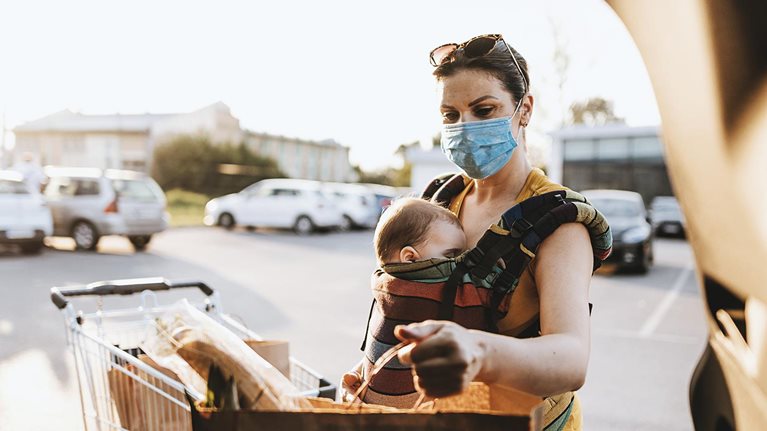In 2020, the sporting goods industry contracted for the first time since the financial crisis of 2007–08. Most brands, retailers, and manufacturers finished the year significantly in the red, despite a bounce back in activity after the first and before the second wave of COVID-19-related lockdowns. The exception was the Chinese market, which continued its role as the industry’s growth engine after expanding at an average of 16.5 percent a year (CAGR) from 2015 to 2019.1 Sporting goods companies saw their market valuations fall in the early months of the pandemic. However, they tended to outperform the wider marker as the year progressed, with sports-equipment makers (particularly bicycle and digitally enabled fitness equipment) doing especially well. Sportswear companies were also more resilient than the rest of the apparel industry (Exhibit 1).

The report is designed to present the latest thinking on themes that will be the cornerstones of the emerging new reality for the sporting goods industry.
The COVID-19 pandemic had a profound impact on the global sportswear market in 2020, with most companies posting weaker sales. Specific sports were impacted with varying degrees, depending on how accessible they were in a locked-down environment. Outdoor individual sports and home workouts both saw increased participation. Team sports and indoor sports struggled, due in part to the postponement or cancellation of major sporting events. Among emerging opportunities, women’s clothing came to the fore amid increased focus on activities such as home workouts, running, yoga, and Pilates.
The impact of the pandemic goes beyond temporary performance—it has also accelerated changes that will have long-lasting impacts on companies throughout the sporting goods value chain. COVID-19 has ushered in the next normal for the industry, defined by factors including digital commerce, rising demand for sustainable products, and increasing participation in individual forms of sports and exercise. To win in the new environment, the industry needs to adapt both its customer proposition and its operational capabilities.
2020 was challenging, but 2021 will also be demanding. It will offer great opportunity for those who have adapted operations and have the consumer at the center of their efforts.
A look ahead: 2021 outlook
The coming 12 months will likely be characterized by a more positive outlook, albeit amid uncertainty caused by an unfolding second wave of COVID-19 and the relatively slow ramp-up of vaccinations. Executives are cautiously optimistic and are focused on growth opportunities: 64 percent of respondents to the WFSGI–McKinsey Sporting Goods Survey expect “better” or “much better” market conditions. The biggest challenges for the coming year are seen in supply chains and COVID-19-related issues, including ongoing challenges relating to physical-activity levels and indoor- and team-sport participation. The greatest opportunities, meanwhile, are associated with the potential return of large sports events, including, potentially, the Olympic and Paralympic Games and the ongoing rise in popularity of outdoor and home-based sports. Categories that did well in 2020 (including outdoor individual sports, home exercise, yoga, e-sports, and virtual races) are expected to remain popular in 2021. Categories that saw a limited increase in participation, or a decline, are likely to make a partial recovery, but at a lower rate than 2020’s winning categories (Exhibit 2). The great unknown for 2021 is the trajectory of COVID-19. Successful players, however, will be defined by an ability to make smart moves to leverage the opportunities highlighted in the “trends” section of the report.
The coming year will continue to be characterized by a lot of uncertainty. We are really thinking about 2021 in a much more modular way. Now we think on a less-than-one-year planning horizon to incorporate much-faster-changing external factors.

Trends set to shape the industry in 2021
The report presents eight key themes set to shape the sporting goods industry in 2021 and beyond. Most were already emerging ahead of COVID-19, but the dramatic events of the past year have accelerated their introduction and heightened their impact. The research shows it will be critical for sporting goods players to align with these evolving dynamics in order to succeed in the next normal. The trends can be broadly described under three banners: consumer shifts, digital leap, and industry disruption (Exhibit 3).

Consumer shifts
1. Athleisure—the new default and a competitive battleground. Athleisure was a megatrend before COVID-19, but the pandemic has served to further blur the lines between work and free time, and there is a rising acceptance of comfortable wear in previously more formal contexts. With fashion brands increasingly entering this segment, sporting goods players need to leverage their innovation abilities and market knowledge in order to win in this increasingly contested battleground.
Athleisure is highly competitive, therefore sporting goods need a clear value proposition and focus on material innovation, design innovation, and leveraging of sports DNA.
2. Physical-activity gap—an opportunity to put healthy lifestyles within reach of all. COVID-19 has triggered significant shifts in physical-activity levels. Around 40 percent of people are less active, while around 30 percent are more active. Unfortunately, a physical-activity gap linked to income levels already exists, with less-affluent households tending to exercising less. The crisis will drive more households into lower-income groups, and thus widen the physical-activity gap. The sporting goods industry should therefore embrace a multistakeholder approach to tackle physical inertia, particularly in the communities left behind.
Sporting goods has seen some level of uptake driven by more health-concerned customers.
3. Sustainability—the COVID-19-accelerated next normal. Sustainability has become an increasingly urgent consumer priority, and companies have responded by introducing more sustainable products—a trend accelerated by the pandemic. The onus is now on companies to secure sustainable supply chains. Since recycling is likely to be a bottleneck, brands need to engage with innovative concepts, such as direct-to-consumer circularity.
I believe brands have to take responsibility, not just to design and produce circular products, but also to organize what will happen with the product after use, for example, creating effective back-loop systems.
Digital leap
4. Digital-enabled fitness and exercise communities take center stage. The past year saw a drastic shift toward digital fitness, driven by physical-distancing and stay-at-home requirements. Digital fitness won’t fully replace traditional sports and exercise but rather will enhance them in a “bionic” hybrid model. Digital workouts will continue to be a hot trend for 2021 and beyond, particularly when they offer an engaging and inspiring element and allow remote exercising in a simulated community setting.
People seek community, even when they are at home.
5. Leap forward in online—an accelerating business-model shift to direct to consumer. COVID-19-related store closures lifted the online growth curve to a new level, enabling multiple brands to grow e-tailing and even direct-to-consumer sales. As a result, the past year has seen a leap forward in online shopping, and many first-time shoppers will stick with their new habits. With online penetration expected to stabilize at around 25 percent in 2021, six times higher than before the pandemic, brands and retailers need to adjust their business models fast. Brands need to put digital commerce at the center and accelerate direct to consumer, and retailers need to deliver seamless and integrated omnichannel experiences.
The shift toward direct to consumer is difficult and requires fundamental change in company structure, mindset, expertise, and knowledge.
6. Marketing shift from assets to influencers—an opportunity to make digital pay. Digital marketing traditionally focused on assets with broad visibility (for example, club, league, or event sponsorships). With sporting events cancelled, postponed, or played in empty stadiums, and consumers spending even more time online, sporting goods industry players need to shift to digital. Furthermore, to build awareness, credibility, and engagement, brands need to increasingly work directly with individual athletes as influencers, who have a much longer reach than events or associations. However, as athletes are role models, and consumers expect them to take a stance on topics important to them, brands needs to ensure alignment with these messages.
A big shift can be seen toward athletes who are able to drive content that has quality while making the product look good.
Industry disruption
7. Retail under pressure—but a critical part of the future channel mix. Brick-and-mortar stores were already under pressure pre-COVID-19, and lockdown measures have accelerated the retail crisis amid widespread closures and increasing financial pressure. To attract consumers back to stores, retail needs to find new purpose, new experiences, and new levels of convenience that cannot be offered digitally.
Physical retail is never going to go away ... Retail has a role to play in providing consumers with a unique experience, versus just piling a lot of inventory in the store and driving sales.
8. Supply chains—the flexibility imperative and a raised bar on agility. More agile supply chains have become a permanent feature on company agendas. In a post-COVID-19 world characterized by shorter demand cycles, e-commerce, and closer direct-to-consumer relationships, they will be table stakes in some markets. Amid persistent uncertainty, it will make sense to both build stronger supply-chain partnerships and explore alternatives such as near-shoring.
Localization will be the number one trend. Second, we are going to see more volatility. Direct-to-consumer models, especially e-commerce, will require shorter lead times ... And finally, I think suppliers will push for more automation.
Winning in the next normal
Pre-COVID-19, many companies were riding a wave of increased sports participation. COVID-19 has also raised the bar for winning, amid tougher market conditions, pressure on physical retail, and the need for investment to align with an increasingly dynamic industry landscape (Exhibit 4). In the next normal, winners will be characterized by:
- a strong presence in growing segments and sports categories, including women, China, and athleisure (which we predict together will account for around two-thirds of growth in 2020 to 2023), as well as running and biking
- an excellent direct-to-consumer business model, including a proprietary e-commerce and seamless omnichannel offering, powered by a cutting-edge back end (expertise, fast development cycles, and omnichannel capabilities)
- direct connection to consumers, through digital communities, loyalty programs, and the like
- a purpose-driven retail footprint, with specific formats for different store types
- credibility on sustainability, either as a differentiator or on par with industry, at a minimum
- revisited supply-chain relationships, with built-in agility (for example, local-for-local sourcing and closer partnerships)
- sports marketing optimized for digital channels, with a focus on influencers (for example, individual athletes) who are aligned with brand values
- agility in planning and budgeting, to respond quickly to changes in the market environment (including a potential reemergence of COVID-19)

Winning players will not necessarily possess all these attributes. However, those that can get a grip on most of them will be best positioned to create a virtuous cycle of commercial excellence, increased sales—leading to higher fixed-cost degression—and more cash for investment. Players that fail to make the necessary changes, conversely, may find themselves stuck in a vicious cycle of worsening commercial performance, higher relative costs, and decreasing investment potential that will undermine their ability to realize opportunities.
Download Sporting Goods 2021: The next normal for an industry in flux, the full report on which this article is based (PDF–9.39 MB).


